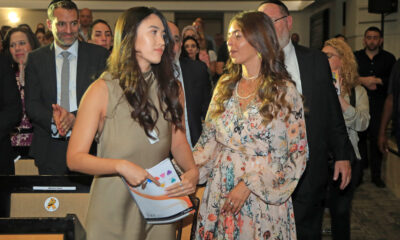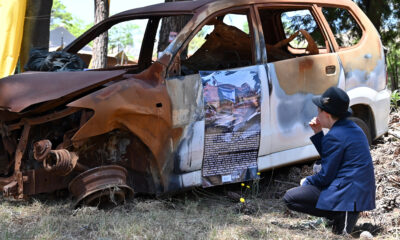
Israel

Kibbutz Nir Am calls on South Africans to help rebuild
“Many people compare 7 October to the Holocaust, but in fact, that day launched Israel’s second War of Independence, and so much is riding on what we do from now to save our country,” said Ron Maoz on Kibbutz Nir Am on the Gaza border this week.
“We need to reunite our people and connect with communities outside the country to rebuild our country”, said Maoz, who was in a top marketing and business development position until 7 October.
On that day, he packed in his job to drive down south to help “save the country” on the Gaza border. “I understood that if we didn’t do it, no-one would.”
Maoz spent the first few weeks “bringing in gear and food and other necessities for soldiers and pulling people out of the area”. He helped take 55 000 “refugees” from the south, and settle them in 70 hotels in Tel Aviv.
He has since dedicated his time to help rebuild Kibbutz Nir Am, just one kilometre from the Gaza border, which had been targeted for destruction on 7 October. However, despite it being miraculously saved from Hamas infiltration, it’s now a ghost town with its inhabitants housed in Tel Aviv.
Nir Am, with the assistance of the Jewish Agency for Israel, is partnering with the South African Jewish community to help reignite its future after the devastation of this war on the areas on the Gaza border.
“It was pure luck that Hamas didn’t manage to get onto our kibbutz,” said Noam Rodman, who is part of the kibbutz’s security leadership. “We later found out that they had a Nahkba Force [elite Hamas unit who first crossed the border on 7 October] far bigger than the one that attacked the devastated Kibbutz Be’eri [4km further from the border], but they weren’t able to carry out their plan.”
Initially, the kibbutzniks didn’t pay too much attention to the ongoing missiles overhead, which numbered more than usual on the morning of 7 October. However, when they heard the automatic weapons shooting nearby, they realised they had a problem.
“We heard automatic weapons going off without stop, and we know that when the IDF [Israel Defense Forces] shoot, they shoot one bullet at a time. So, we knew something was very wrong, and we rushed to the shelter where we keep our weapons and prepared to fight off anyone who came near our kibbutz,” said Rodman.
Hamas operatives managed to get into the kibbutz’s chicken hatchery, killing one worker and kidnapping another. The Druze worker who was kidnapped was Samer Talalka, 22, who was later killed by friendly fire with three other escaped hostages.
“Only two Hamas operatives managed to get onto the kibbutz, but they didn’t get past us,” said Rodman proudly.
Another “bit of luck” was the fact that the electricity had been taken out by a missile, jamming the main gate closed, said Rodman. “We have footage of Hamas trying to get in, but eventually giving up and going on to Sderot [a border town that was ravaged by Hamas on 7 October].”
Hamas operatives were also stopped from getting into the kibbutz by Golani soldiers, who fought off the oncoming marauders nearby. After a fierce battle, killing one soldier who dived onto a live hand grenade to save his unit, Hamas redirected its killing mission to other kibbutzim and Sderot.
However, 11 out of 12 Gazan men who worked on the fields adjoining the kibbutz were slaughtered by Hamas that Saturday morning as they worked. One was rescued by the kibbutzniks. These Gazans were from one Palestinian family who had worked for the kibbutz for many decades.
On the bodies of Hamas operatives who were killed nearby, they discovered maps of the kibbutz, showing exactly who lived where, how many in each family, their ages, and other vital information. “We believe the family who worked for us may have been forced to give this information, but they still came to work on a day they probably weren’t allowed to. Whether we will ever hire Gazan workers again we cannot say now,” said Rodman.
Despite this kibbutz being virtually untouched, the sense of security that withstood all the years of living so close to Gaza is gone. Today, out of 650 kibbutzniks, there is a maximum of 30 there at any given time.
In the middle of the night of 8 October, buses arrived at the kibbutz to relocate people to hotels in Tel Aviv. There were still Hamas operatives around, but kibbutzniks had to be evacuated for their safety, said Avi Kadosh, one of the seniors on the kibbutz. Thereafter, they will be moved a little closer to Ashkelon, he said.
Kibbutz Nir Am has a high percentage of young families, with more than 200 children, although it was founded in 1943 as one of the first kibbutzim in the area. It’s best known for its factory producing silver cutlery and pots. “We have 95 percent paradise here, and 5 percent hell,” said Kadosh. Despite being the kibbutz with the most hits from rockets over time, there have been no physical injuries to date, he said.
“We may not have had people killed here, but our people have been damaged by 7 October. Our children were at school with children murdered or orphaned that day,” said Kadosh. “Our kibbutzniks need a lot to be able to want to come back home.”
Also, some family members want to return to the kibbutz and others don’t, which causes huge distress within family units. “We ultimately need to bring back our kibbutzniks to start the healing process,” said Kadosh.
To do so, Maoz said, they need to build three main circles of trust. The first is security, which must be built alongside the army, police, fire department, and Nir Am’s own security infrastructure. “Nobody can come back and not worry about terrorism as things stand right now,” he said. “We need to build trust in our country’s leadership on all levels, the government, municipality and others because people have lost this trust. The third is to build trust with each other. We all need to work together to heal on the kibbutz and the country.
“We then need to ensure we have the best opportunities for our children’s education and future. The goal is for all the families to come back and more families to build Nir Am, but they must believe they have something worthwhile to return to.”
Maoz said the South African community could help with different kinds of therapists, teachers, people knowledgeable in agriculture, and generally people who want to contribute.
“We want to reignite this community because this kibbutz is based on that. Walls can be built, but strong communities aren’t so easy to recreate,” said Maoz. “Right now, the community is fragile, and we want to connect with South Africans to help us recreate what this kibbutz once was and can be again.”
Maoz said the kibbutz wants to build a swimming pool as a communal gathering place, and student dorms as there is a college nearby. “We need to build industry on the kibbutz and bring in new blood, and we could certainly use help and support,” he said.
Should you be interested in finding out more about helping Nir Am, please email Ronli Dorfman at ronli@sazf.org.










